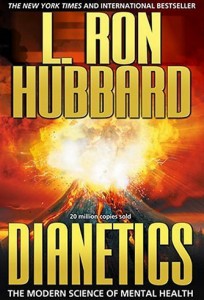 Welcome to our ongoing project, where we blog a 1950 first edition of Scientology’s bible, Dianetics, with the help of ex-Scientologist, Bay Area lawyer, blogger, and author Vance Woodward. Go here for the first post in the series.
Welcome to our ongoing project, where we blog a 1950 first edition of Scientology’s bible, Dianetics, with the help of ex-Scientologist, Bay Area lawyer, blogger, and author Vance Woodward. Go here for the first post in the series.
This week we have a short chapter in which Hubbard defines the four dynamics. Yes, four. Later, he will expand them to eight, but for now, we have four dynamics for survival — the self, sex, the group, and all mankind.
Earlier, Hubbard had introduced the idea that the purpose of life is to survive, and that we have more pleasure in our lives the closer we are to immortality, and more pain the closer we are to death. He defined something that tended to keep us from immortality as a “suppressor.” (And it’s important to remember that word for later.)
For now, Hubbard expands the idea of survival, saying that we are trying to survive in different realms, not only as individuals, but we’re also trying to leave behind children to carry on our names, and we also want the entire race to persevere.
He proposes that the best possible plan of action is one that benefits all of those goals at the same time. Or, the way he puts it that will become a kind of mantra in Scientology, “The Equation of the Optimum Solution would be that a problem has been well resolved which portends the maximum good for the maximum number of dynamics.” (Emphasis his.)
As we will see, that becomes a rather sinister formulation in the church, as it becomes the ultimate justification for “the ends justify the means” behavior.
But we were struck by something else in this chapter. Once again, Hubbard tries to convince us that these are not the philosophical musings of an eccentric pulp fiction writer, but instead are the rock-solid results of “laboratory” research.
“In the original equations of dianetics,” Hubbard writes to open the chapter, “when the research was young, it was believed that survival could be envisioned in personal terms alone and still answer all conditions…But when addressed to the laboratory — the world — it did not work….A new computation was made on the survival dynamic….And now it was found, a theory was in hand which worked. It explained all observed phenomena and it predicted new phenomena which were discovered to exist. It was a scientific equation, therefore!”
Did you see that trick there, Vance? Having slipped back into passive voice, Hubbard once again tries to give us the sense that some sort of controlled, scientific testing was applied to his ideas. But just there, do you see that interesting admission that he makes? His “laboratory” is in fact “the world” — in other words, there is no controlled scientific experimentation, but instead Hubbard trying out his ideas on friends and neighbors. Or something. Once again he doesn’t give us a single clue about what science there is in his infallible scientific discovery.
We’re finding it hard to discover anything very impressive about this survival business and the dynamics. Maybe you could help us understand what Scientologists think of this.
VANCE: A few things come to mind. First, I remember an OT VIII (someone who has reached the highest spiritual level, when you learn from LRH that all of the results of the exorcism therapy you’d spent years on was all just in your head) saying to me that the key was to get people in when they’re young. This was only a few years ago. Of course, that sounds sinister. But when you’re in, it makes sense. Young people are bright eyed, eager to please, and aren’t jaded yet. It’s easier to get young people interested in anything, including Scientology. So, that’s relevant here in the sense that this might appeal to people who haven’t been exposed to any of these ideas before. When I first read Dianetics, this stuff was new to me. I mean, I simply took it at face value as something that might profoundly help me. I wanted it to help me. That’s significant. If you’re already reading this stuff with the hope that it will do something for you, it stands a good chance that it will. Of course the reverse is true too. I call that The Dynamic Principle of Self-Deception. It was discovered by me while doing hard science in, uh, scientificism. For $1,000, I’ll explain it in detail. But whatever you do, don’t look up the meaning of confirmation bias.
The second thing is that I’m realizing now that Hubbard consistently conveyed information in this manner. It’s like he’s dishing this stuff out from a huge plate of brilliance, and he’s having trouble coming down to my level. So, I always have this feeling like I’m not quite getting what he’s saying but that he expects me to get it. It feels like I’m trying to keep up to understand these obscure statements that are apparently full of meaning … if only I were smart enough to decode them. At the same time, it’s like he’s letting me into his universe. He’s no stuffy, pompous academic. He’s a man of the world, talking from experience and a well-organized mind. Four dynamics, eh? OK. Wow. Let me see. Interesting. Do we weight them? Does this mean I’m as important as the entire human race? Uh. I guess I’ll find out how to actually use these things later. Better keep reading.
For most Scientologists, the dynamics are a weapon, and they come up in the context of demands for time and money. When you’re dependent on (addicted to) Scientology, the dynamics come in the form of: Give all your time to the Church, give your time directly and in the form of money, all of it. Do that because that’s best for the world. It was like I was sitting there pointing a gun at my head, and other Scientology addicts would come around to help me pull the trigger because doing so was “the greatest good for the greatest number of dynamics.” It’s not for everybody. I eventually grew bored of it, but not until I financially wiped myself out. Seriously, at the time that I was handing over big money, I actually thought of it as “pulling the trigger,” but I didn’t understand the analogy in quite the way that I do now.
THE BUNKER: This short chapter on dynamics is followed by an even shorter one that summarizes all that we’ve learned in Book One. Hubbard does a couple of really interesting things in this short summation.
First, even though it’s been pretty clear that everything in these early chapters has been quite creative but also completely unscientific, Hubbard now insists that his musings are now “axioms” of dianetics — in other words, infallible, scientific truth.
“THESE ARE THE FUNDAMENTAL AXIOMS OF DIANETICS” he thunders.
Among those axioms: that survival is the point of life. That we are trying to survive in four different “dynamics” — self, sex, group, mankind. That we are all striving for immortality and feel pain if we can’t achieve it.
And now, even though he’s summing up what he’s written earlier, Hubbard introduces some new words we haven’t seen before.
“The dynamics are inhibited by engrams, which lie across them and disperse life force.”
And
“The reactive mind is that portion of the mind which files and retains physical pain and painful emotion and seeks to direct the organism solely on a stimulus-response basis. It thinks only in identities.”
Also
“Psycho-somatic ills are caused by engrams. The engram is the single source of aberration and psycho-somatic ills.”
He goes on to say that engrams are only received in an unconscious state, and that they contain painful memories that aren’t available to our “analytical” or conscious minds.
Well, that’s a lot of new information thrown at us in a short chapter that’s supposed to be a summation of what came before. We can only expect that he’ll be explaining these things in greater depth later. But once again, Hubbard is pelting us with unscientific concepts without even attempting to describe how he came to these ideas or how they could be tested by an independent observer.
It’s quite a flourish to end the first book. And to top things off, Hubbard leaves us with what must be one of the squishiest equations in the history of social science.
“The potential value of an individual or a group may be expressed by the equation PV = ID2 where I is Intelligence and D is Dynamic.”
We don’t remember seeing that in later Scientology materials, but maybe we’re wrong about that. Vance, are Scientologists still being told their potential value is equal to their intelligence times dynamic squared? It does have a certain ring to it.
VANCE: Oh boy. Uh, no. I don’t believe I’ve ever heard anybody ever mention that equation. I’ve certainly never heard of anybody trying to measure these things. Talk about obscure. Why squared? Do we do this for the sum of the dynamics or by individual dynamic and then apply some tomographizer to get a net geometric fractal of the summation-thingy? Whatever it means, it’s sure a brain tickler. Maybe we need a cup of “life force” to fully comprehend it.
Like you say, the real criticism isn’t that the man is expostulating but that he’s shamelessly tossing this stuff out there as scientific fact. And I know we already covered this but this really does show me that the text selects for a certain type of individual, or more accurately a certain combination of circumstances. I mean, a pre-Scientologist would have to approach this with a sincere desire for improvement rather than with an open mind, much less a critical mind. By the way, having an open mind in Scientology is one of the numerous ways you that can get yourself labeled as a “Potential Trouble Source.” Not joking. It’s right up there with having a felony record. Keep an eye on that girl. She steals stuff. No, forget about her. See that guy? His mind is gaping wide open. Do something!
Hey, when you know that you have all the answers, it makes sense.
Anyhow, when I first read this equation, I remember having a vague curiosity about how anybody could measure D, the dynamic. I didn’t quite articulate it at the time, but I figured that this was a construct. Basically, somebody’s potential value is a metaphorical product of their vibrance and intelligence. And a person’s actual worth, W, is their PV for a particular dynamic multiplied by some vector that represents the optimum survival, OS, for that dynamic. So, W = PV x OS. They’re vectors, like arrows. If they line up, you get a bigger value. If they don’t align, you get a small value. And you can even get a negative value.
I think I actually wrote that out or something like that the first time I read the book. And it made me feel good that I could sort of extract that out of what LRH wrote. It’s like, “Hey, I understand you have a lot of ground to cover and you can’t spoon feed everything to me. But I’m tracking, man. I get what you’re saying, man.”
THE BUNKER: Clearly, you worked hard to make sense of this book. And for that we salute you.
Next week — Blogging Dianetics, Part 5: Your Mind is a 1950s Computer
Blogging Dianetics, part 1: The opening sentence!
Blogging Dianetics, part 2: The State of Clear!
Blogging Dianetics, part 3: The Meaning of Life!
————
Posted by Tony Ortega on January 25, 2013 at 07:00






